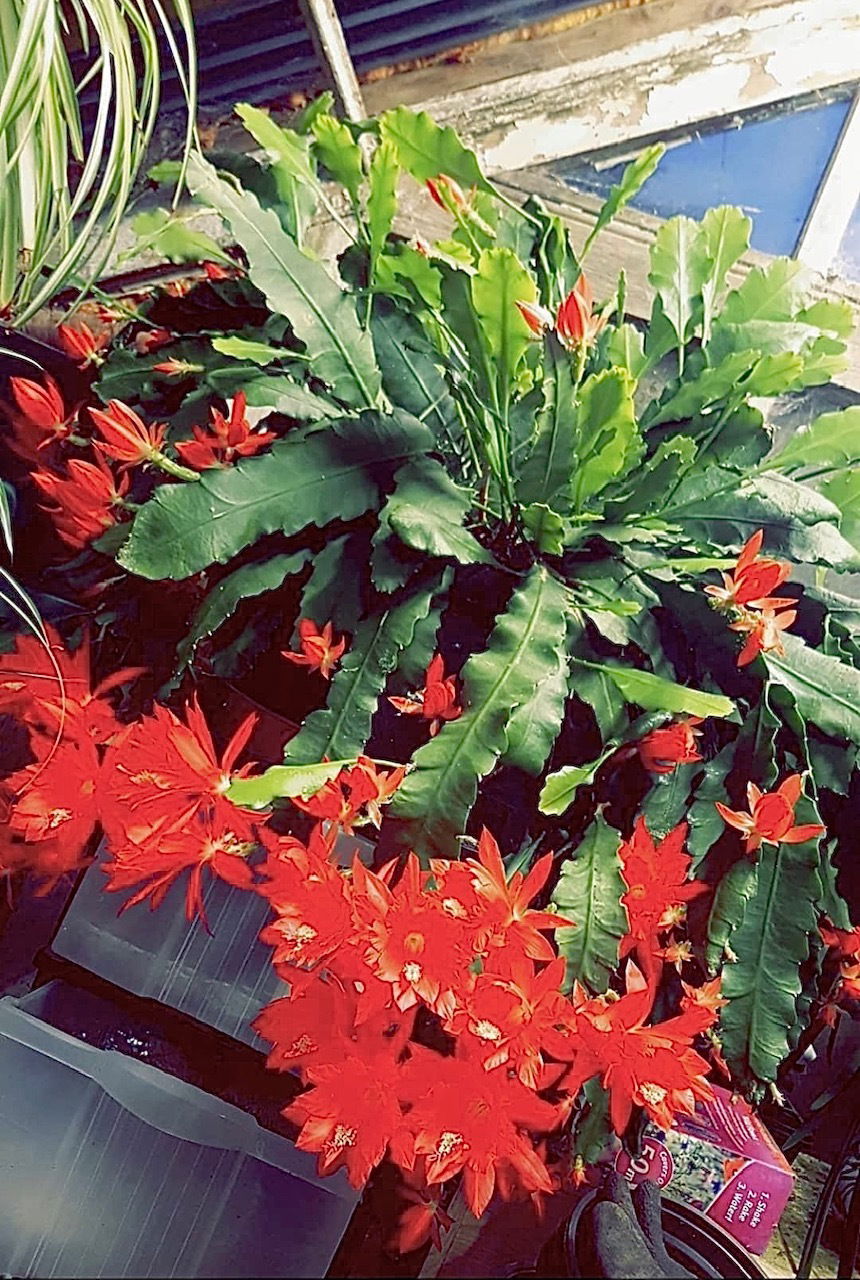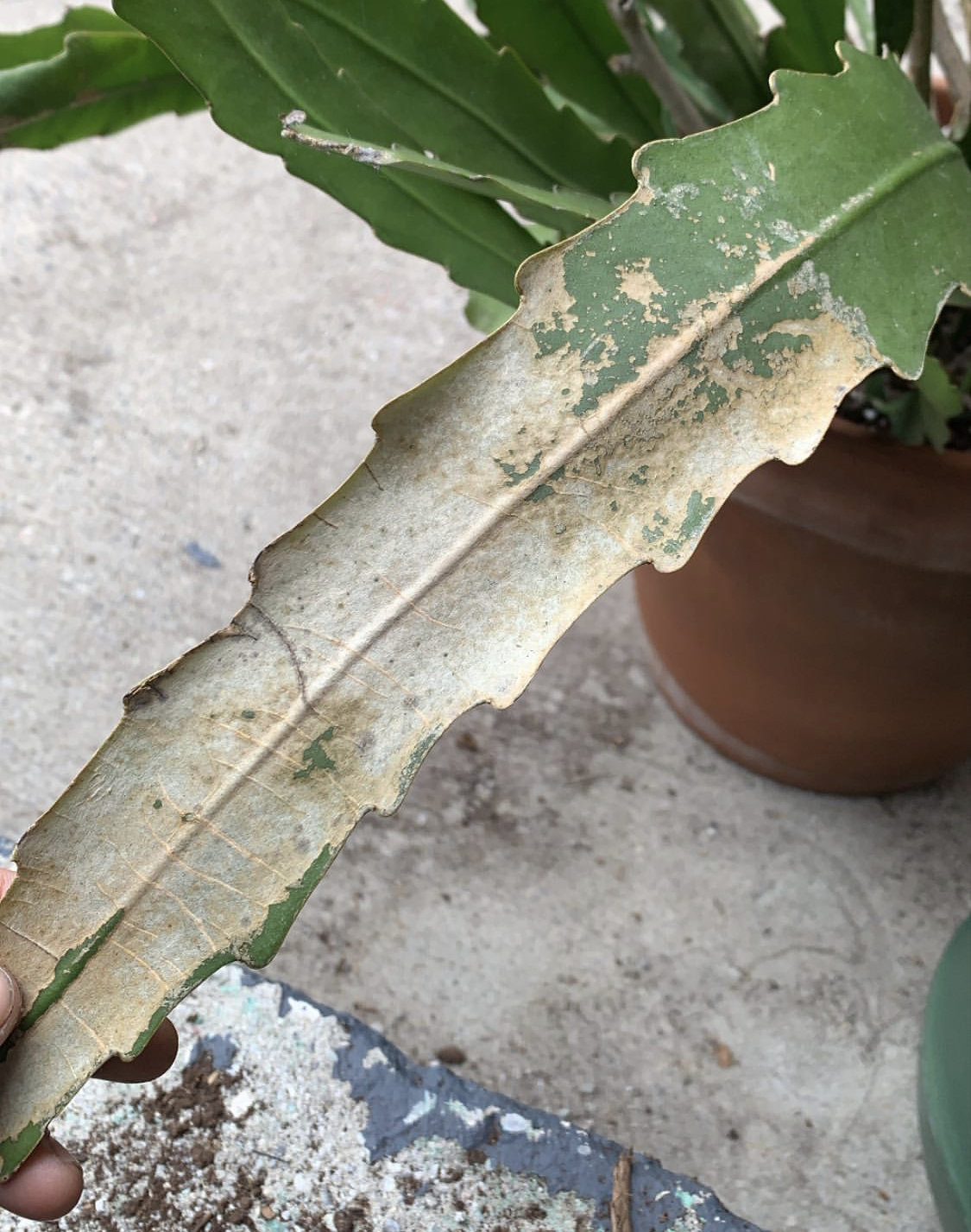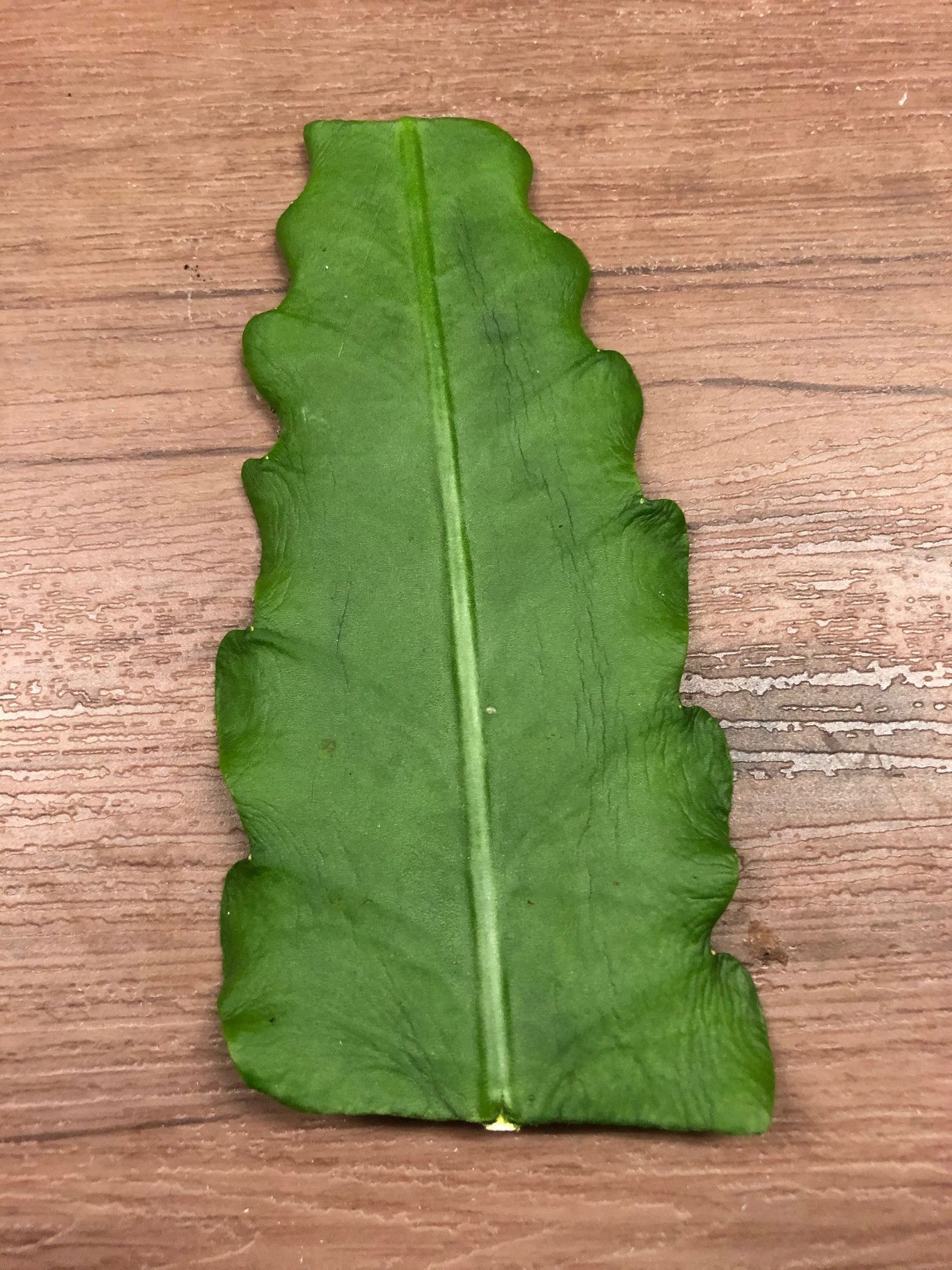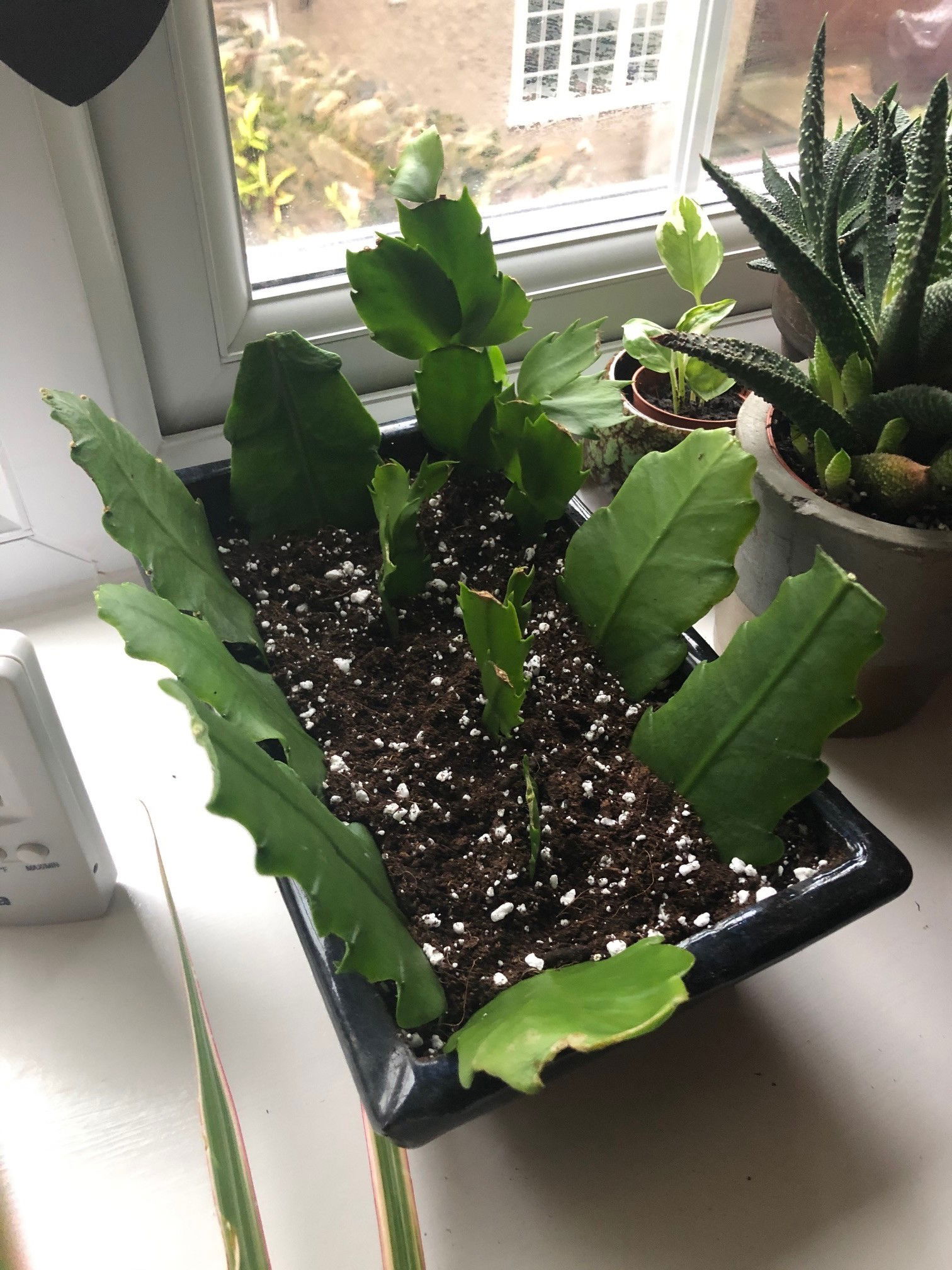
Disocactus × hybridus 'Red German Empress'
Contents
- Top Tips
- Location, Water, Humidity & Fertilisation
- Dormancy Care & Annual Flowers
- Common Issues
- Origins, Temperature, Propagation, Repotting & Toxicity.
Need the answer to a specific plant query? Book a 1-to-1 video call with Joe Bagley, the website's friendly author, to overcome and address your niggling problem! Available on iMessage, WhatsApp, Facebook Messenger & more.
Top Tips & Info
- Care Difficulty - Easy
- Provide a bright, indirect location away from the direct sun, avoiding shady areas entirely.
- Less is more with Orchid Cacti; water once the soil's top half dries out, reducing this further in the autumn and winter.
- Average room humidity is enough to please this species, but introduce a pebble tray to keep the surrounding moisture high in locations near a heat source (heaters or radiators).
- Fertilise using a 'Houseplant' or 'Cactus' labelled feed every four waters in the spring and summer, reducing this to every six in the colder months.
- Regularly check for pests, most notably Mealybugs and Scale that'll inhabit the cubbyholes of the stem.
- Keep the ambient temperature above 10℃ (50℉) throughout the year, especially if placed outdoors in the summer.
- Repot every three years using a 'Cactus & Succulent' potting mix, in the next sized pot with adequate drainage holes.
Location & Light - 🔸🔸
Bright, indirect light is favourable; however a darker location won’t do too much harm either. A position that offers more than two hours of strong direct light must be kept off the cards, due to their susceptibility to sun-scorch. A location within three metres of a north, east or west-facing window, or below a skylight window are the ideal areas, or even a frost-coated conservatory.
Water - 🔸🔸
The rule of thumb with Orchid Cacti is to allow the soil's top half to dry out in between irrigations. Once the pot begins to feel light, and the top layer of the compost feels wholly dry, it's time for another drink. Be sure to reduce this further during the autumn and winter to replicate their dormancy period and downplay the risk of over-watering. Whilst in bloom during the summer, avoid the use of cold water due to the species' sensitive nature to cool root temperatures. Under-watering symptoms include little to no new growth, a much-needed transplant and drying leaves. Over-watering symptoms, on the other hand, include yellowing leaves that soon drop off, little to no growth and root rot. These are common with too much soil moisture, an improper soil medium or deep shade. If the foliage directly above the soil line becomes brown and mushy, the chances are root rot has occurred; take stem cuttings on non-affected growth by following the tips mentioned in 'Propagation'.
Humidity - 🔸🔸🔸
A good level of humidity should be at the forefront of Orchid Cacti cultivation. The introduction of a pebble tray will help replicate its natural habitat in tropical forests in the Americas. Botrytis petal blight and southern blight are caused when excess moisture (from misting or messy irrigations) is allowed to settle in the cubbyholes of the flowers or stem.
Fertilisation - 🔸🔸
Fertilise every four waters during the growing period before reducing this to every six in the autumn & winter. Although a 'Houseplant' fertiliser will still do the job, we'd recommend using a specific 'Cactus' labelled feed as it'll support the vital thirteen nutrients that this species will need to grow.
Whilst the plant is budding or in bloom, swap for a potassium-based feed, for example, 'Tomato' food, to prolong the flowering process in the late spring. Never directly apply an RTU (ready to use) feed without a pre-water first, as this will result in root burn and yellowed leaves.
Dormancy Care & Annual Flowers
A specimen will flower once it hits maturity, which can take up to three years in some cases. As ukhouseplants been challenged many times on this subject, we've created an acronym to help you through this process - SHORT. The combination of drying soil, cooler temperatures and dark nights will contribute to better flowers in the following season. Repotting isn't mandatory, but instead might hurt the chances because of transplant shock and stress. The following steps must be taken from autumn to winter, to provide the best possible dormancy period.
Sunlight
Be sure to provide a bright location with little to no direct sunlight. Although the winter rays won't necessarily hurt the plant, be careful not to fall in the trap of sun-scorch and severe dehydration.
Avoid the use of artificial lighting at night or locations that boast temperatures higher than 18℃ (64℉).
Hydration
Reduce waters so that at least three-quarters of the soil becomes dry. It's essential to keep them on the drier side to life, as they'll think that hard times are ahead and therefore will need to pass its genes on to the next generation.
Occasional Feeds
One or two feeds using 'Cactus & Succulent' fertiliser is all that is needed for supplementation, as too nutritious soil will reduce the chance of blooms in the summer.
Reduce Everything
This one is a reminder to reduce everything - especially the temperature.
Temperature
This is the most significant step; reduce the temperature down by around 5℃ compared to the summertime or place in a room that's between 13º - 16℃ (56º - 61℉). You'll be at a significant disadvantage if the ambient temperature is kept constant throughout the year, as they'll only respond in locations that have daily fluctuations of around 5℃. Never exceed the minimum temperature as it may lead to plant death or yellowed foliage at a bare minimum.
| Time of Year | Care Requirements |
| January & February | Resting/Dormancy Period. Reduce irrigations and fertilisation. |
| March | End of Resting/Dormancy Period. Increase waters and feed using a 'Houseplant' labelled fertiliser every four waters. |
| April | Pre-Flowering Period. Use a 'Tomato' labelled feed every four waters during this period. Water once the top their of the soil dries out. |
| May & June | Flowering Period. Maintain moist soil and continue to use the 'Tomato' labelled feed every forth water. |
| July | End of the Flowering Period. Gradually decrease both water and fertiliser intake in the soil. Remove spent flowers as they wilt. |
| August & September | Water once the top third of the soil dries out. Supplement using 'Houseplant' feed every six waters. |
| October - December | Resting/Dormancy Period. Reduce irrigations and fertilisation. |
Common Issues with Orchid Cacti
Root rot is a big issue with symptoms including yellow lower leaves, stunted or softened growth - often accompanied by stem collapse. Take the plant out of the pot and inspect its root systems. Yellow roots translate to good health, however, brown and mushy sections with soggy soil is the result of over-watering. More information about addressing root rot can be found on this link.
A brown, rotten base is also another byproduct of over-watering. If the majority of the trunk has rotted over, stem cuttings must be taken to save the remaining section of the plant. Scroll down to ‘Propagation’ for more information!
For smaller compact specimens, yellowing central leaves or a naked base are products of excess moisture being allowed to sit on the foliage. Although watering from the top is acceptable, it's recommended to use the bottom-up method to reduce the chance of rotten foliage. For those that have a bare head over the soil, improve growing contains by using this method and increasing light levels. Promote a bushier appearance by taking vine cuttings and placing them halfway down into the soil once the stems reach over 5cm. Immediately remove yellowed or rotten debris as this will harbour both bacterial and fungal diseases that can both spread across to other sections of the plant.
 Excessive woodiness (or 'Corking') is a normal phenomenon with Orchid Cacti. In some cases, it could be the product of over-exposure to the sunlight, but it'll inevitably occur over time as your specimen will mature!
Excessive woodiness (or 'Corking') is a normal phenomenon with Orchid Cacti. In some cases, it could be the product of over-exposure to the sunlight, but it'll inevitably occur over time as your specimen will mature!
Mould or mushrooms developing on the soil means two things - too little light and over-watering. Despite the harmlessness, it'll prove unsightly to most gardeners and is therefore removed once known. To remove, replace the top two inches of the soil for a fresh batch of 'Cactus & Succulent' compost. Either increase the amount of light received (no direct sunlight for the first few weeks to prevent environmental shock) or decrease the frequency of waters slightly. If the mould is accompanied by yellowing lower leaves, you may also have a case of root rot.
Blisters appearing on your Orchid Cactus is most likely due to over-watering. If this has occurred with yours, improve your watering regime by allow ALL of its soil to dry in between drinks. You could also try relocating the plant into a brighter windowsill to dry the soil out quicker, thus reducing the risk the soil becoming wet and stagnant. The blisters should eventually harden over so you don't need to prune it off.
Failed leaf or stem cuttings are a common issue among amateur gardeners, with damaged wounds or too small vines being the usual culprits. Although propagating all tropical cacti is relatively easy, people still find it hard to ace. Not only will the size of the vine dictate its success, damaging the leaves or vine can also hurt the chances of rooting. For more information about how to take vines, scroll to the 'Propagation' section of this article.

Too much sunlight will cause a red tinge to the foliage. Although Orchid Cacti are best grown in locations offering just a few hours of sun, prolonged periods on non-acclimated specimens will lead to sun-scorch. If yours is a newly-purchased plant, build its tolerance to the sharp rays by increasing the amount of receivable light per week by an hour. (The plant pictured is a Thanksgiving Cactus, but it behaves in the same way when exposed to sunlight with its red leaves).
A lack of flowers is caused by immaturity or an insufficient dormancy period served in the winter months. Specimens will only flower once they reach maturity - which can take in the region of three to six years from a leaf cutting. Also, locations that offer near-similar temperatures all year round won't allow the plant to go dormant, resulting in poor spring growth. To achieve bud development, situate in a location that offers nighttime temperatures of around 12°C (54°F) with fewer waters. The combination of both cooler temperatures and dry soil during the colder months will help season the plant, thus leading to a better chance of flowers in the future.
Always use lukewarm water, and if you choose to use tap water, allow it to stand for at least 24hrs before application. Tropical cacti tend to be quite sensitive to temperature change, so pouring cold tap water immediately into the pot will not only ironise your roots but could even cause yellow edges, sudden flower loss and stunted growth.
Origins
There are several different Orchid Cacti in cultivation, in the guise of species, cultivars and naturally-occurring hybrids. Unfortunately, the taxonomy of Orchid Cacti is confusing. The argument of whether they belong in the Disocactus or Epiphyllum genus has been ongoing for decades. And even when they've decided on a family name, the species name is contradictory, too! The Disocactus × hybridus, pictured above, originates from Guatemala and was first described in the early 19th century. This hybrid is among the most popular among Orchid Cacti growers, due to its fragrant red flowers that are put on show in the spring or summer. The other popular Orchid Cactus, Disocactus ackermannii, has be reclassified FIVE TIMES since its discovery in 1829 by Adrian Haworth - Cactus ackermannii (1830), Cereus ackermannii (1837), Phyllocactus ackermannii (1842) and Nopalxochia ackermannii (1935) before the current Disocactus ackermannii in 1991.
 The Distribution of the Genus, Disocactus.
The Distribution of the Genus, Disocactus.
Temperature
10° - 26°C (50° - 78°F)
H1a (Hardiness Zone 13) - Must be grown indoors or under glass all year round. Never allow temperatures to dip below 15℃ (59℉) or permanent damage may occur in the likes of flower loss, stunted growth and blackened or yellowed leaves.
Spread & Maintenance
Up to 0.8m in height and 1m in width, with true maturity taking up to eight years.
Pruning & Maintenance
Remove yellow or dying leaves, and plant debris to encourage better-growing conditions. While pruning, always use clean utensils or shears to reduce the chance of bacterial and fungal diseases. Never cut through yellowed tissue as this may cause further damage in the likes of diseases or bacterial infections. Remember to make clean incisions as too-damaged wounds may shock the plant, causing weakened growth and a decline in health.
Propagation
Via Seed or Leaf/Stem Cuttings.
Soil Propagation of Leaf Cuttings
- Choose which leaves to use. The ideal candidates are those that show no sign of damage, pests or diseases, and have small wires roots already-attached. Cuttings that don't have any roots will still root, but it may take a little longer for its propagation.
- Delicately prune the whole leaf off from the plant, and cut it into several sections sideways. If you're stuck on which way to propagate the leaves, look at the image below.

- Prepare the pot and soil. Choosing a free-draining potting mix, for example, 'Cactus & Succulent' compost, which provides a nice balance of moisture-retention and drainage. Of course, most soils are acceptable (Houseplant or Multi-purpose compost), but try to add some extra ingredients like grit, sand and perlite to help loosen it up. If you've got any shallow and wide pots, for example, a Bonsai pot, this is the time to use it. Propagating tropical cactus cuttings won't require deep soil, so try and avoid pots that are too big. Terracotta and plastic pots are both acceptable in this instance.
- Place the cuttings ON TOP of the moist soil. Allowing both the plant and it's wound to callus over (dry out & harden) will kick-start the rooting process, along with the prevention of rot. Keep the cuttings on top of moist soil for a week, misting the soil and foliage on opposite days.
- Provide a bright, indirect location with temperatures above 18°C (64°F) throughout this period.
- Then, place the cuttings into the soil, submerging the bottom third. Make sure you don't set it too deeply, as this may lead to 'Blackleg' (the rotting of its base).

- Do NOT pat down the surrounding soil to aid support. The ideal soil conditions need to be fluffy and oxygenated, so compacting the soil will result in the suffocation of roots that'll lead to root rot. Tap the pot's side to consolidate (not compact) the soil. If support is needed, use a small stick or cane, but be sure NOT to condense it.
- Aftercare - Maintain evenly moist soil, allowing the top third to dry out in between waters. The ideal location would be in a warm, humid room within a few metres of a window, but out of direct light. After another month or two of being in the soil, treat it like a normal houseplant.
Flowers
Orchid Cacti will flower between late spring and summer with rosette-shaped blooms, sporting either red, yellow, pink or white appearances. Each flower will take several weeks to develop, lasting only a few days once opened. Most cultivars or species will produce a sweet-smelling fragrance that'll be most prominent at night. Be sure to take photos of your specimen in bloom, as the flowers will only last a few days!
Repotting
Repot every three years in spring using a 'Cactus & Succulent' labelled potting mix and the next sized pot with adequate drainage. Orchid Cacti are far better being potbound for several years due to the heightened risk of root rot and repotting-issues (like transplant shock), so only repot if you feel it's wholly necessary - restricted root growth will also increase the chance of blooms, too.
Hydrate the plant 24hrs before tinkering with the roots to prevent the risk of transplant shock. For those situated in a darker location, introduce an extra amount of perlite and grit into the deeper portion of the pot to downplay over-watering risks. Click on this link for a detailed step-by-step guide on transplantation, or via this link to learn about repotting with root rot.
Book a 1-to-1 video call with Joe Bagley if you'd like a personal guide to repotting your houseplant. This will include recommending the right branded-compost and pot size, followed by a live video call whilst you transplant the specimen for step-by-step guidance and answer any further questions!
Pests & Diseases
Keep an eye out for mealybugs, spider mites, whitefly, scale & vine weevils. Typical diseases associated with Orchid Cacti are root or leaf rot, leaf-spot disease & powdery mildew. For more information on how to address any of these issues, click on this link - Identifying Common Houseplant Pests & Diseases
Toxicity
Orchid Cacti are classified as non-poisonous. If large quantities of the plant are eaten, vomiting, nausea and a loss of appetite could occur.
Retail Locations
Online Stores.
Book a 1-to-1 Call with Joe Bagley
If you need further advice with your houseplants, book an advice call with ukhouseplants' friendly and expert writer today! This can be done via a video or audio call on most apps, including Facebook, FaceTime & Skype. A ten-minute call costs £5.99 (US$7), or £15.99 for thirty minutes. You can ask multiple questions, including queries on plants, pests, terrariums, repotting advice and anything in between. Please consider supporting this service to keep ukhouseplants thriving!